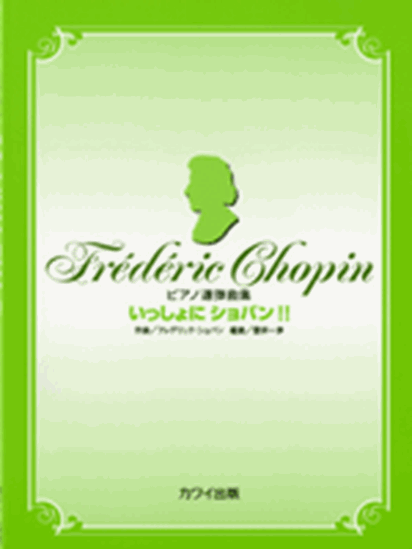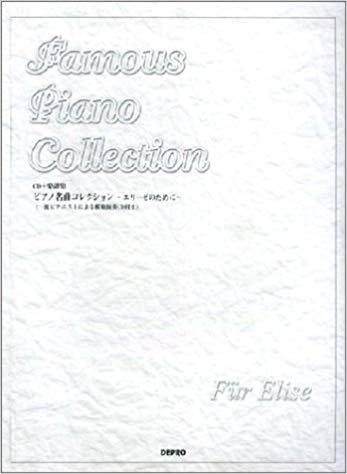Chopin, Frederic : [Fantaisie-] Impromptu (posthume) cis-moll Op.66
Work Overview
Publication Year:1855
First Publisher:Schlesinger, Meissonnier
Dedicated to:le Baronne d'Este
Instrumentation:Piano Solo
Genre:inpromptu
Total Playing Time:5 min 30 sec
Copyright:Public Domain
Commentary (2)
Author : Asayama, Natsuko
Last Updated: July 1, 2008
[Open]
Author : Asayama, Natsuko
Impromptu
"Impromptu" originates from Latin, meaning "unprepared." The term is said to have been first used in 1822, when two composers coincidentally employed it simultaneously for their own works. As a musical genre, the impromptu has little relation to improvisation as a performance technique. It merely signifies a piece of music that reflects an improvisatory atmosphere, and it is a musical genre from the 19th century onwards. (While the idea of improvisatory music itself is by no means unique to the 19th century, it was previously known by various names such as toccata and capriccio.)
In the first half of the 19th century, the tradition of the impromptu largely followed two main currents:
- One involved continuous variations on popular opera arias or folk melodies, exemplified by Czerny, Kalkbrenner, and also some fine works by Liszt.
- The other comprised lyrical musical content without a specific form, represented by Voříšek and Marschner, who are said to have first used the term, as well as Schubert's impromptus. However, even if the form is not fixed, many exhibit an A-B-A arch structure.
Chopin inherited the tradition linked to Schubert, leaving behind the Fantaisie-Impromptu and three Impromptus during his middle creative period. All of them have a clear arch form, with the middle section designated "sostenuto."
This work is the first Impromptu written by Chopin, dedicated to Princess d'Este in 1835, and fair-copied by the composer himself into her music album. However, Chopin did not intend for it to be published at that time. The first edition was published posthumously by his friend Fontana in Germany in 1855 and in France the following year. However, this appears to be based on a source different from the Princess d'Este's music album. According to Fontana, Chopin composed the Impromptu in 1834. If so, the first edition score would have documentary value as an earlier draft than the autograph fair copy. The significant differences between these versions are that the middle section was changed from "Largo/Moderato cantabile ♩=88" to "più lento/sostenuto," and all metronome markings were removed. In the first edition, the opening Allegro agitato also had a marking of "half note = 84." If the first edition truly is based on another lost autograph manuscript, then it can be said that Chopin's fundamental conception of the impromptu changed or became established within the short period from 1834 to 1835. The first edition also shares many points of agreement with a copy by Chopin's friend Franchomme, making the existence of another autograph manuscript highly probable. Furthermore, the title Fantaisie-Impromptu is also attributed to Fontana's first edition; Chopin's autograph manuscript simply bears the title Impromptu.
The "improvisatory" technique employed in this work is largely similar to that found in the First and Third Impromptus, but it is not particularly effective here. Additionally, while the left hand is divided into three, the right hand is divided into two, creating two parallel streams that never intersect. However, even this does not quite manage to shake off the insistent two-beat pulse. Ultimately, the charm of this piece lies in the beauty of its melody. Despite the persistent repetition of such a sentimental melody—the fact that the piece, though entirely in a minor key, hardly conveys any sense of seriousness is thanks to this transparent sentimentality—it can truly be said to be the work of a genius in melodic beauty.
Author : Ooi, Kazurou
Last Updated: March 12, 2018
[Open]
Author : Ooi, Kazurou
General Approach
This is a typical piece that should not be played strictly in time; it is rare to find a piece that sounds so strange when played rhythmically. The key to this piece is, frankly, that playing “as one feels” is ultimately important. However, this does not mean neglecting basic technique. This piece has another typical characteristic: it allows for “considerable leeway.” Learners should first diligently master the left-hand and right-hand passages perfectly, and then “break” the piece.
Technical Advice: A Section (m. 5 onwards)
From measure 5 onwards, when played without the pedal, the evenness of the left-hand sextuplets becomes clear. Three notes in the left hand against four in the right hand is arithmetically indivisible. Therefore, one plays without thinking about such things, but then it becomes difficult to notice if the left-hand passage is uneven. In such cases, removing the pedal helps clarify this.
The two difficult parts in this A section are measures 7-8 and measures 11-12. If you can manage to play these two parts, the rest will fall into place. For example, measure 7 of measures 7-8 is almost entirely arpeggios and scales. This part is manageable. Measure 8 is tricky; practice it with various approaches. Fingerings might also be important.
Technical Advice: A2 Section (m. 13 onwards)
From measure 13 onwards, a different problem arises. In this section, only one note per beat is truly essential, and the rest must be played pp. People who have trouble in this section either:
- lack basic muscle strength,
- have independence issues, or
- have extremely small hands.
Perhaps it's two of the three, or even all three. Here's one practice method: let's take the first beat of measure 13 as an example. Hold the G# octave with fingers 1 and 5 simultaneously. While holding, try trilling the inner B# and C#. Now, hold the inner B# and C# simultaneously, and then try to arpeggiate the octave. If both work well, try repeating just the first beat many times without stopping. If you can play it this way, this part is fine.
Practice playing all units in this manner. Those with small hands, of course, do not need to sustain the melody line like in Bach. As long as the sound sustains for one beat with the pedal, you can lift your fingers from the keys. From measures 13-16, the first note of each of the four beats in the right hand should also function as a quarter note. Therefore, make these notes clearly audible as the melody line, and play the remaining three notes as pp as possible.
Melody Line and Dynamics (m. 17 onwards)
Now, in the author's score, the beginning of the beat remains a quarter note from measure 17 onwards, but in many scores, isn't there an accent on the higher note of the off-beat? In other words, the higher note now becomes the melody line. In this case, too, naturally, everything except the melody line is played pp.
I believe that “bringing out only the melody line and playing the rest pp” is quite difficult. Therefore, I will teach you an effective practice method. With the tempo significantly reduced, play the melody line ff and everything else pp. If you can't do it, reduce the tempo even more. You can even drop it to quarter note = 30 or less. In any case, choose a tempo where the difference between pp and ff can be clearly distinguished. Try practicing at that tempo. If it goes well, gradually increase the tempo, but maintain the distinction between pp and ff.
If, during this practice, a learner cannot produce pp, first try playing all 16th notes ff. Then, try again. If you cannot produce ff, pp becomes very difficult. The same technique is required from measure 119 onwards. Are there accents written? By the way, the melody line in measures 119-120 is E E D# D# C#.
Musical Interpretation: A Section (m. 5 onwards)
Now, let's move on to the musical discussion. Please refer to the first page. You can divide it into a total of three phrases: one in measure 5, one in measure 6, and one in measures 7-8. There is only one 16th rest between these three phrases. If you play these three phrases strictly according to the score, like a computer, it will be disastrous. The music will be completely lost. Therefore, when playing these three phrases, consider each phrase as “one block.” And it is important to take a sufficient “breath” before the next block. However, as mentioned earlier, there is only one 16th rest between phrases. Therefore, apply rubato. For example, play the 15 16th notes in measure 5 as one block, all at once, faster than the tempo. This way, since it's faster than the original timing, there should be a gap of more than one 16th rest before the next phrase. And that is actually the desired performance approach.
- Take enough time between phrases.
- This means playing the 16th notes all at once, faster than planned, and taking that saved time for the rest. This is the first important point.
The second point is about balance. With so many notes written, and the right and left hands very close, the sound becomes dense. The balance issue lies with the left hand. Play all notes in the left hand except the bass notes at ppp. In other words, play them almost inaudibly. These two points are crucial when playing this A section.
Musical Interpretation: A2 Section (m. 13 onwards)
From measure 13 onwards, let's call it A2. The melody line in this section is G#, F#, E#, F#, C#, D#, E, G#, G#, F#, E#, F#, E#, F#, A, G#. Try playing these notes as a single melody line. And apply plenty of rubato. When applying rubato, the first G# will take a considerable amount of time, then once the next F# starts, the music moves forward, and the last three notes, around F#, A, G#, will likely slow down considerably, ending as if slowly fading away. Try it many times. And grasp a natural flow that satisfies you.
Once you can play it as a single melody, add the other notes, reproducing that flow exactly. You will notice that there is considerable variation in the speed of the 16th notes. In this way, you must proceed freely, unconstrained by the beat.
Musical Interpretation: A1 Return (m. 30 onwards)
Returning to A1, from measure 30, become slightly agitato and increase the tension. The tempo should be forward-moving. The dynamics are a crescendo. And reach measure 37. This is the goal. The tempo around here should also be quite free, with plenty of rubato.
Musical Interpretation: Lyrical Section (m. 40 onwards)
Measures 40-41 are an important part leading into a new section. Some editions may have an ff marking at measure 41, but do not take it literally. Enter measure 41 naturally, carrying over the flow from measure 40.
From measure 42, you enter the lyrical section. A typical mistake is playing this section p. Of course, the dynamic marking might be p, but a lyrical section, no matter how pp, must be clearly conveyed to the listener's ear. Avoid producing dying or blurry sounds, and smooth shaping is also required.
The issue of balance is also important here. The left hand should be pp. There is an f marking at measure 60, but the author would not play it that strongly. It must be a memorable sound, but avoid a sudden, sharp forte sound. Change the color in measures 62, beats 3-4. I think it's fine to use the soft pedal.
A typical mistake in this section is treating ornaments, such as those written on the fourth beat of measure 65, in a very mechanical way. Remember, this is a melody sung by a singer. Even these notes – F, E-flat, D-flat, E-flat, F – must be melodic. And they cannot be sung that fast. Play them slowly, without stiffness, moving towards the F at the beginning of the fourth beat. From now on, treat such ornaments musically.
Final Advice
At measure 129, in the calm after the storm, the melody of the B section resurfaces in your mind. Play the melody of the B section with the left hand, maintaining its shaping exactly.
When playing the final chord as an arpeggio, change the D# (the top note of the previous measure) to C# while holding it down with finger 5 or similar. This is to ensure the melody is never interrupted. For your reference.
Arrangements & Related Works(1)
Fantasie Impromptu (arranged by Gould, Shefter): 幻想即興曲(2台ピアノ)
Total Performance Time: 4 min 40 sec
PTNA & Partner Channel Videos(10items) View More
Reference Videos & Audition Selections(8items)
Sheet MusicView More
Scores List (90)

(株)ドレミ楽譜出版社

(株)全音楽譜出版社

(株)全音楽譜出版社

(株)全音楽譜出版社

(株)全音楽譜出版社

(株)全音楽譜出版社

(株)全音楽譜出版社

(株)全音楽譜出版社

(株)ドレミ楽譜出版社

(株)ドレミ楽譜出版社

(株)音楽之友社

KMP(ケイ・エム・ピー) ケイエムピー

(株)ヤマハミュージックエンタテインメントホールディングス

(株)ドレミ楽譜出版社

KMP(ケイ・エム・ピー) ケイエムピー

ミュージックランド

(株)シンコーミュージックエンタテイメント

(株)ドレミ楽譜出版社

ミュージックランド

ミュージックランド

(株)タイムリーミュージック

ミュージックランド

(株)シンコーミュージックエンタテイメント

(株)ヤマハミュージックエンタテインメントホールディングス

(株)ドレミ楽譜出版社

ミュージックランド

(株)リットーミュージック

ミュージックランド

(株)シンコーミュージックエンタテイメント

(株)リットーミュージック

ミュージックランド

(株)全音楽譜出版社

(株)ドレミ楽譜出版社

(株)シンコーミュージックエンタテイメント

(株)全音楽譜出版社

ハンナ(ショパン)

(株)ヤマハミュージックエンタテインメントホールディングス

(株)ヤマハミュージックエンタテインメントホールディングス

(株)ヤマハミュージックエンタテインメントホールディングス

(株)ヤマハミュージックエンタテインメントホールディングス

カワイ出版

ハンナ(ショパン)

ミュージックランド

ミュージックランド

ミュージックランド

(株)シンコーミュージックエンタテイメント

(株)ドレミ楽譜出版社

(株)シンコーミュージックエンタテイメント

KMP(ケイ・エム・ピー) ケイエムピー

(株)シンコーミュージックエンタテイメント

ハンナ(ショパン)

(株)リットーミュージック

(株)ドレミ楽譜出版社

(株)共同音楽出版社

(株)ヤマハミュージックエンタテインメントホールディングス

(株)シンコーミュージックエンタテイメント

(株)シンコーミュージックエンタテイメント

ハンナ(ショパン)

ハンナ(ショパン)

(株)ヤマハミュージックエンタテインメントホールディングス

KMP(ケイ・エム・ピー) ケイエムピー

ハンナ(ショパン)

(株)ドレミ楽譜出版社

(株)シンコーミュージックエンタテイメント

ミュージックランド

(株)ヤマハミュージックエンタテインメントホールディングス

(株)ドレミ楽譜出版社

ミュージックランド

デプロMP

(株)ヤマハミュージックエンタテインメントホールディングス

ミュージックランド

(株)全音楽譜出版社

カワイ出版

(株)ドレミ楽譜出版社

(株)自由現代社

(株)音楽之友社

(株)音楽之友社

(株)ヤマハミュージックエンタテインメントホールディングス

ポーランド音楽出版社

ハンナ(ショパン)

(株)ヤマハミュージックエンタテインメントホールディングス

Neil A. Kjos Music Company

Musikverlag Doblinger

ミュッセ

(株)ヤマハミュージックエンタテインメントホールディングス























